Hello –
I’m here today to talk to you about Things Rules Do.
My name’s Tom Armitage, and I really like games.

Hello –
I’m here today to talk to you about Things Rules Do.
My name’s Tom Armitage, and I really like games.

I like games that look like this…
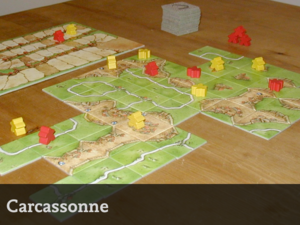
…and games that look like this…
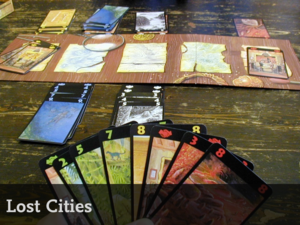
…and games like this.
I like thinking about games, too, and as a result I’m always re-evaluating why I like them. And I tend to come to the conclusion that there’s lots of reasons. I like playing with my friends. I like playing things that are empowering. I like challenging myself.
Fairly near the top of the list of why I like games these days, though, is that I like them as systems. I like their rules.
I don’t really like rules because I like following rules. Nor because I like rulebooks (although there are many that I am rather fond of).

I like them because I like their insides. The inside of a game – the metaphorical inside, really – is a big, clockwork machine. And just like a beautiful watch, they are often as elegant on the inside as on the outside.
That makes it sound like I like complexity. Some of the rules and mechanics I’m going to show you today are rather complex, and are not going to appeal to everyone. But some of the best rules and mechanics are the simplest. Elegant systems can be either simple or complex, and it turns out that elegance – stemming from either style of system – is just plain difficult to achieve. Don’t think I’m down on fun, or down on simplicity.
This is a short, twenty-minute exploration of a few things that rules and systems do within games – and within other systems – that I think are surprising and interesting, and why they appeal to me.
It’s worth starting by just deciding for the purposes of the next nineteen minutes what rules are. I’m particularly fond of this definition, from Eric Zimerman and Frank Lantz (from this essay).
“Rules are the formal structure of a game, the fixed set of abstract guidelines that defines the functioning of the game-system.”
Rules don’t just tell you what to do; they tell you how to process action and react to it accordingly. Rules are instructions for feedback loops – and rules are the building block ofs of systems..
And, of course, there are individual game mechanics – which I’m going to conflate with rules a lot in this talk. Why? Well, sometimes they sit atop those rules – and sometimes, such as the way chess pieces move, they’re an equal part of those rules. It’s a complex relationship, which I am going to gloss over entirely for the purposes of talking about something interesting.
Here’s somewhere to begin.
Let’s start with the idea that rules are constraints. And let’s go back to Lantz and Zimmerman again.
“To play a game, players voluntarily submit their behaviours to the limits of the game rules. Once play begins, players are enclosed within the artifical context of a game – its ‘magic circle’ – and must adhere to the rules in order to participate”
Of course, once you’ve been sucked into that magic circle, we agree to be bound – there you are, the language of constraint again – by the rules. And having entered into that shared pact with our fellow players, we have to understand exactly what our new constraints mean.

There are lots of ways to reach that point of understanding. You often begin by reading rules – when you open a boardgame, you’ll find the rulebook fairly near the top of everything. But of course, once you’ve read them, you’re pretty soon going to realise you have to play the game to really understand it. And, as you play, you return to the rulebook, back and forth. You’re not just reading the rules; you’re ingesting them. The players of a boardgame are the virtual machine it executes on, if you like. But, because we’re people, and not computers, an exciting thing happens when we start using these rules/
Play happens.
We’re constrained by the rules, but when we understand the nature of those constraints, we can’t help but play with them – wriggling and stretching them as far as they’ll go. Knowing the rules means understanding both what they mean, and the potential they affords.
Now, of course, there’s a funny thing about computer games that’s a bit different to this example. The rules aren’t laid out for you.
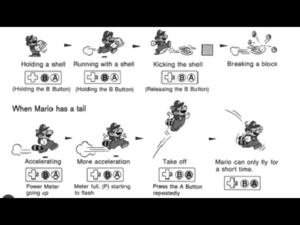
You get an instruction manual with most videogames [slide], but it doesn’t describe the systems in play; it just describes your interface to them. And so the first thing you’re really doing when you sit down with a game is reverse-engineering the rules of the system: providing input, parsing output, repeating in a big feedback loop.

Jump on the monster, see what happens, work out whether or not to do it again. The end result is the same, though: the rules get under your skin. You’re effectively storing a mirror image of the game’s systems in your head – mirrored, because it’s from the perspective of a player

As you gain mastery over a ruleset through understanding, you start to see the places those rules can bent.
Not broken: this isn’t about cheating, or glitching, or explicitly disregarding what’s written down in the rules. This is about taking advantage of the things left unsaid. It’s about the give in those constraints – quite literally about *playing* with – and within – those rules.
I played a lot of QuakeWorld… gosh, in the last millenium. Ouch. One early technique that was very rapidly discovered and embraced by players was rocket jumping.
The principle is simple: there’s a mechanic by which the rocket launcher in that game doesn’t just cause a lot of damage; it also propels things caught in the explosion away – including the player. So, if you have a lot of health and armour, and, whilst running, point straight down, jump, and fire a rocket under yourself… as well as causing yourself some damage, you’ll go a very long way.
And it turns out this opens up interesting shortcuts and new strategies, and far from being a bug, it turns out to be exactly what you’d hope it’d be: an interesting side-effect of the game engine behaving _exactly as it should_. And ever since it’s been an integral part of the game.
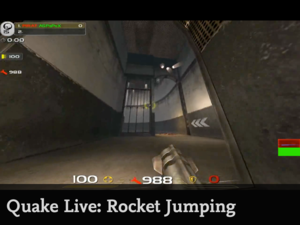
In the most recent iteration of what I’d recognise as Quake – the browser-based Quake Live – there’s a rocket jump training stage. [Slide]Here’s a short example of it. Remember, this is a game mainly about shooting other players, but id have taken this interesting bending of the system, and will now coach you in it.
Look, he’s going around corners!
New techniques like this create new culture around that bending – like Speedrunning.

Speedrunning is attempting to complete a game as fast as possible. The first speedrun Quake Done Quick, in which the entire game of Quake was completed in 19 minutes, is a speedrun I first encountered in that previous millenium. (The record’s now at about 12 minutes).
In a speedrun like QDQ, you bend the rules as much as possible: you take the level out of sequence, use tricks like bunnyhopping and rocketjumping to navigate the environment more quickly. And by doing this, it turns out that you can finish games far faster than ever intended. Speedrunning makes speed the competetive element of these games.
Explain.
This doesn’t rely on cheats, or bugs – it’s just genuinely creative within the systems the game offers. Trying to bend or abuse the rules is pretty much the same as trying to play by them. You’re respecting their constraints, but stretching them as far as they’ll go. Rules demand to be bent.

This doesn’t rely on cheats, or bugs – it’s just genuinely creative within the systems the game offers. Trying to bend or abuse the rules is pretty much the same as trying to play by them. You’re respecting their constraints, but stretching them as far as they’ll go. Rules demand to be bent.

The best rules bounce off one another; on their own, they don’t look like much, but the way they combine with one another leads to marvellous, dense systems. Rules build on other rules.
This is one of my favourite types of layered systems: the 2D fighting game. Something I’m not going to talk about now; instead, I’m now going to let Dave Sirlin teach you to play Super Street Fighter II Turbo. If you learn only one thing about this game, this is it.

That’s it. That’s the game; it’s about controlling space, and knowing priority of moves. Of course, the 16 characters all bring slightly different movesets to the game. They all interact with space very differently, like chess pieces – and this is chess at 90mph. And as you merge all those little mechanics together on top of the base layer – and factor people into the equation – you end up with this massive set of meshing cogs. And your only hope is *not* to take it all apart, every second, but just learn the game to the point it’s inside your head and your hands, and you just feel it. Working through a complex system leads to mastery of it.


Rules can tell you how games are to be played.
“Isn’t that what rules do?” you might ask. Well, I don’t mean that kind of “how”. I mean: they tell you about the context to play these games in.
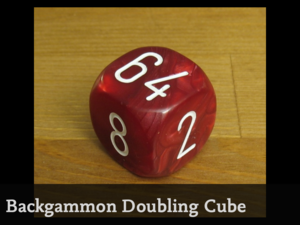
This is a backgammon doubling cube. You might have found it in a backgammon set and likely ignored it. I rarely play with it at home – but it tells you the most marvellous thing about the game.
Not a die; explain rules.
When you first hear this rule, it sounds silly, because you can end the game instantly based on offering a double. It feels like a deeply tactical move – one that requires the skill to see ahead in the game and knowing how it’s going to turn out.
I don’t think it’s about that at all. I think that what that game mechanic is doing is telling you about the nature of Backgammon itself.
It’s a pub game. It’s not a game you play a single match of; it’s a game you play all night, game after game. And, as you play: you drink more beer. And then, four pints down, I offer you a double that I probably shouldn’t. Are you going to back down?
Of course not. There’s a reason it’s called Dutch Courage.
This one little cube is explaining something remarkably simple: it’s telling you that this is a game of bravado and risk, and that it’s fought as a campaign between friends over social lubricants. That cube allows for arrogance, and you will be arrogant once you get on a roll.
And I love it: in that single rule is some history, and some context, and some suggestions for what to do whilst you’re playing.
That, there, is why I like rules. Rules aren’t just about systems and mastery and all the stuff you’d expect games to have. They’re also about so many other things that are just as important – if not more so – to games.

Here’s another thing they do.
Rules and mechanics tell stories.
I’m serious.
Not in the way they’re written, the prose of a rulebook; in the actual balance of those cogs, in the algorithms they run on, in the manner they play out.
I’m going to show you three different stories I like that are hidden in rules.

This is Waldschattenspiel: the game of shadowy woods, quite literally. It’s a game clearly aimed at several children working together against an adult. In it, several dwarves are trying to hide from the light chasing them – presumably, a frightening monster. To do this, they must hide in the shadow of trees.
You could build that with a complex 3D engine, or with clever overlays. But why do that, when you could just, you know [slide] make a light? And not just any old light: but a flickering candle.

A game played out in near-darkness, the room dim, lit only by the candle the dwarves are trying to flee from; a naked flame. When the candle has moved, the candle-player closes their eyes whilst the dwarves find new hiding places.
It’s magic. That’s what it is. In that alone, just in the mechanics of the game, is narrative, and something primal; it is the Brother Grimm made turn-based. The dwarves stay out of the light – real light – and in the shadows – real shadows. When they all meet in the shadow of one tree, they win. You don’t even need to call them dwarves; the dark wood, the flickering light, the threat of discovery, is enough to bring this fairy-tale world to life.

Or consider Brenda Brathwaite’s Train (http://playthisthing.com/train). [Quick explanation]. Iain Schreiber says
“With the flip of one card, you realize what you have done during play. You crammed a bunch of wooden pawns uncomfortably into your train car, even stacking them on top of each other, because you thought it didn’t matter. You played cards to speed your train to its destination. You played intelligently and optimized the mechanics in your favor, and you won. And that means you lost.”
As the rules make clear: Train is over when it ends.
Yes, some of that narrative is within the trappings: the smashed glass; the stations on the cards. But one of the points it is making is about the nature of mechanical systems, and players’ complicity within them. And the other point it is making is so much larger. And it forces you to consider whether you change your goal. As Schreiber says:
“once you do know the results of your actions… do you keep playing? This is the important question that Train asks. It asks using the play of a game, in a way that could not be replicated in any other artistic medium… Do you refuse to play? Do you continue playing, with the new goal of saving everyone (a goal that is very possible within the framework of the mechanics)? Do you keep playing anyway in order to further explore the dark efficiency of the system?”
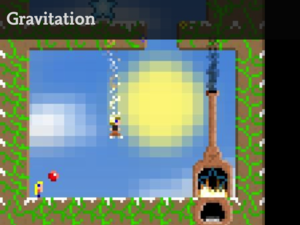
And finally: Jason Rohrer’s Gravitation.
This game broke my heart when I played it. All the Readme would say is: this is a game about work-life balance.
Explain it.
And that’s it. Yes, the aesthetics of the sprites help… but the whole narrative is contained in that viewport scaling as you play with the girl-icon, and fading as you fuel the fire. You internalise the rules, come to understand them, as discussed before – and are left empty, heartbroken, by the knowledge of what you are having to juggle. I found it remarkable. And it’s all in the mechanics.

I am beginning to outstay my welcome. So it’s time to finish up and say goodbye.
In the end, rules are nothing without people. The system is comprised of both rules and human input, human comprehension. We’re back with Zimmerman again. You put people, and rules, together, and you get systems that are dependant on both, and yet more than their sum. You get contexts to play in, and a path towards mastery. You get stories, and you get play.
And you can get these things out of games that look like this, or this, or this.

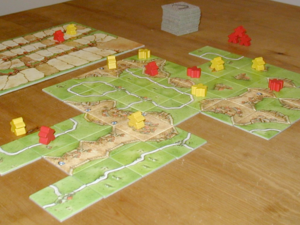
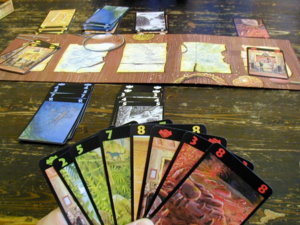

You can get them out of anything where people have agreed how to play – be it hastily concocted rules for a wide game, or the centuries-old game of chess. And there’s nothing else that works like this; games are a systemic media, forged out of the system made between player and ruleset.

Their mechanics are what set them apart from other things, and if they are to tell stories, and inspire mastery, and communicate context, and shape our actions, they need to do that from their very hearts: the beating, clockwork heart, that is their rules.
I hope that was interesting. I’m around all day, so say hello.
infovore.org is a weblog by Tom Armitage, 2003-2026.